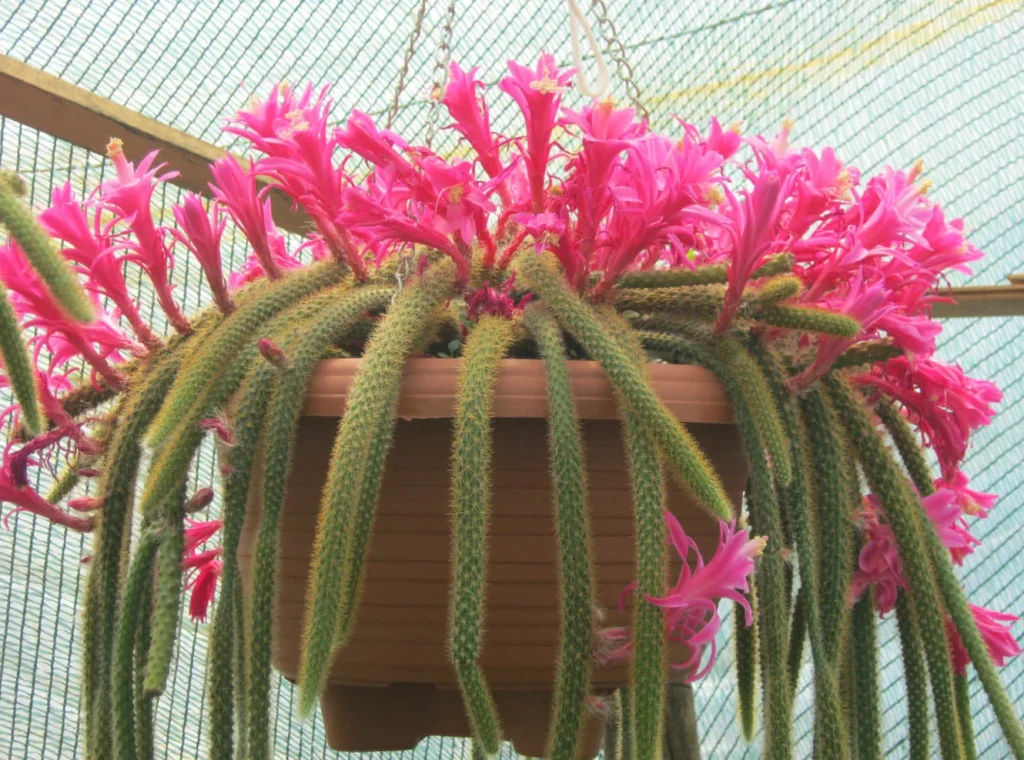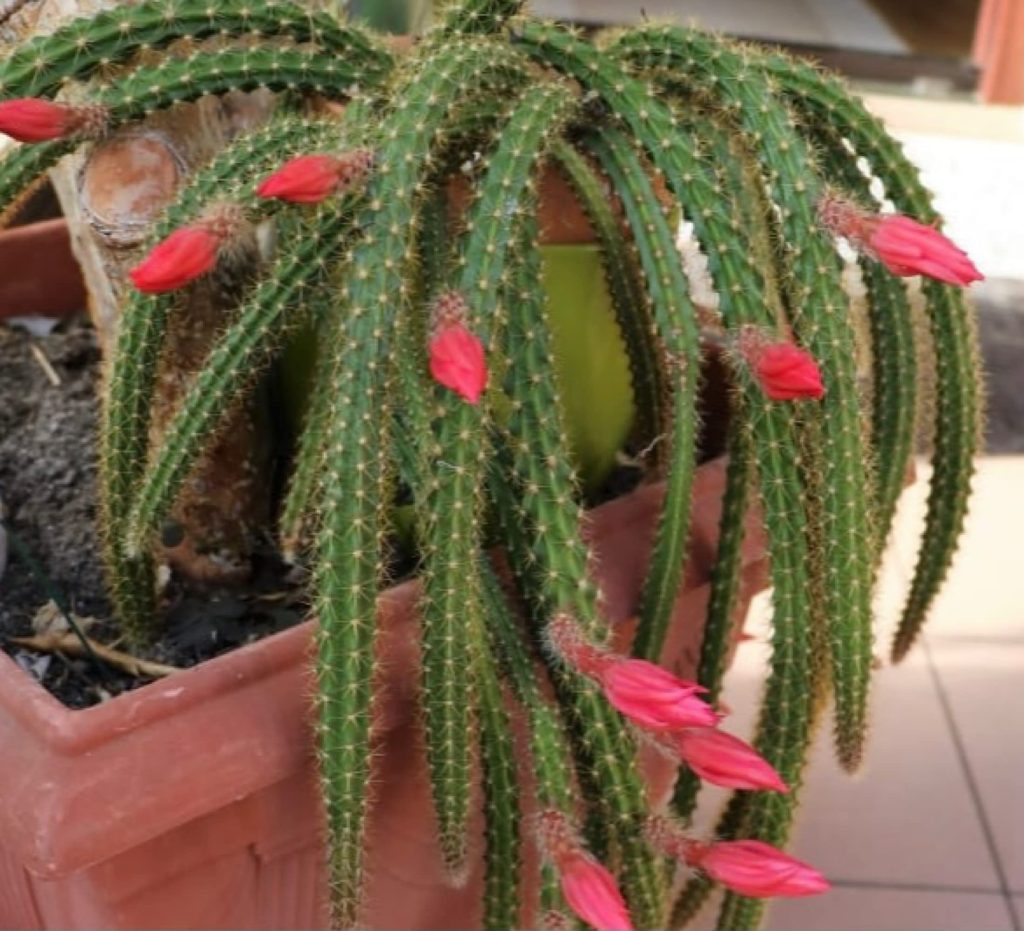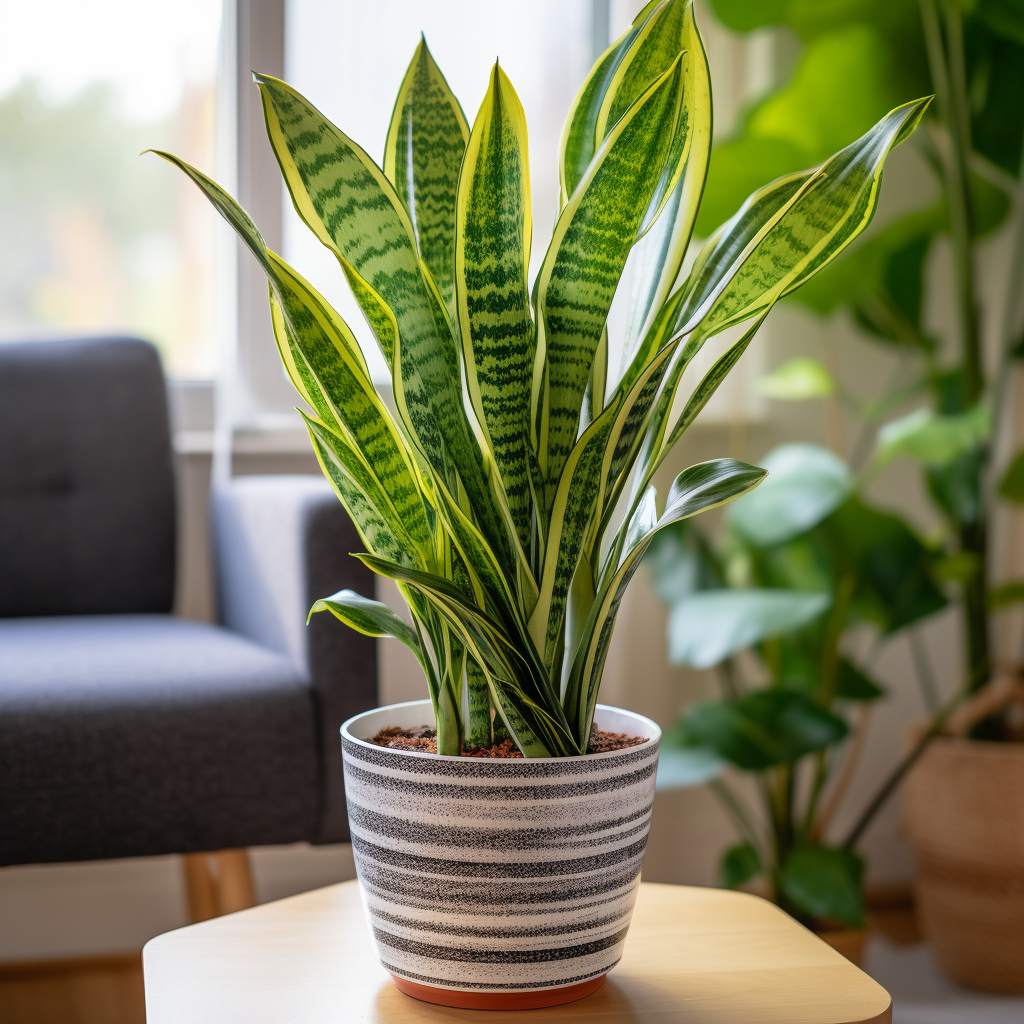Let’s acquaint ourselves with the Rat Tail Cactus, or scientifically termed as Aporocactus flagelliformis. This particular cactus is renowned for its peculiar physical characteristics, closely resembling the tail of a rat, which gives it its descriptive name. Flaunting long, pendulous stems that can stretch up to an impressive 6 feet in length, the Rat Tail Cactus is easily identifiable.
These stems, showcasing a bright green color palette, are punctuated by diminutive spines that closely stud its surface, adding to its unique aesthetic appeal. But the true beauty of this plant comes alive in spring, when the cactus blooms, presenting vibrant pink or red flowers that enhance its exotic charm.
Facts About Rat Tail Cactus

Venturing into the world of facts related to the Rat Tail Cactus, we find it steeped in fascinating information. Originally hailing from the arid regions of Mexico, the Rat Tail Cactus is incredibly adaptable and resilient, flourishing even in desert-like climates.
The unique morphology of the plant, combined with its attractive blossoms, makes it an object of interest for botanists and plant enthusiasts alike. One of the most intriguing facets of the Rat Tail Cactus is its blooming period – the cactus typically flowers in spring, boasting stunning, funnel-shaped flowers that act as a natural magnet for attention and admiration.
Care for Rat Tail Cactus
A significant part of owning a Rat Tail Cactus is understanding the care it requires. A notable feature of this plant is its low demand for water. Given its desert origin, the Rat Tail Cactus is adept at conserving water and can survive on minimal watering.
It’s crucial to prevent overwatering, as this can result in root rot and potentially damage the plant. The Rat Tail Cactus thrives in warm, sunny environments, so finding a spot with plenty of sunlight is ideal for its health. However, keep in mind that it doesn’t cope well with cold weather; hence, if temperatures plunge below 50°F (10°C), it’s advisable to move the plant indoors.
How to Grow Rat Tail Cactus
Growing a Rat Tail Cactus is a simple and fulfilling task, suitable for both experienced gardeners and beginners. The plant primarily propagates through stem cuttings. The process is straightforward: take a cutting from the parent plant, allow it a few days to form a callous at the cut end, and then plant it in a well-draining soil mix. Ensuring the cactus receives ample sunlight and minimal water will see it growing healthily in no time.
Problems that May Occur with Rat Tail Cactus
Despite its robust nature, the Rat Tail Cactus isn’t impervious to certain issues. Overwatering tops the list of common problems, often resulting in root rot. Inadequate light can cause etiolation, where the plant grows tall and spindly, losing its characteristic dense and bushy appearance.
Furthermore, pests such as mealybugs and aphids can infest the Rat Tail Cactus, impacting its health. Regular inspections of your plant for any signs of distress or illness is key to ensuring its longevity and growth.
Is the Rat Tail Cactus Poisonous?
For those of you who share your space with pets, there’s good news! The Rat Tail Cactus isn’t known to be poisonous. However, it’s a good practice to keep such plants out of reach of pets. The spines on the cactus, while not toxic, can cause discomfort or injury if your pet comes in contact with them.
Is Rat Tail Cactus Indoor Or Outdoor?
The Rat Tail Cactus boasts a flexible nature, making it adaptable for both indoor and outdoor growth. Its preference for warmth and sunlight makes it a perfect candidate for outdoor gardening. Simultaneously, it adds a touch of greenery and exotic appeal when kept indoors, especially when hung in baskets where its tail-like stems can trail attractively. During colder months, it’s essential to move the plant indoors to shield it from the frost and cold.
How Much Light Does A Rat Tail Cactus Need?
The Rat Tail Cactus has a fondness for sunlight. It thrives best in bright, indirect light conditions. While it can tolerate direct sunlight, scorching rays could potentially harm the plant, causing sunburn. It’s therefore advisable to provide some shade during the peak sunlight hours to protect your cactus.
Is Rat Tail Cactus Fast Growing?
When compared to other cacti, the Rat Tail Cactus demonstrates a relatively rapid growth rate. With the right conditions—ample light, warmth, and judicious watering—the cactus can reach its full length within just a few years.
Conclusion on Rat Tail Cactus
In the vast world of succulents, the Rat Tail Cactus carves out its distinct place with its unique physical attributes and easy-to-grow nature. Its intriguing form, coupled with the stunning spring blooms, makes it an engaging addition to any garden or indoor plant collection. While it’s not immune to certain issues, proper care can ensure a thriving, vibrant Rat Tail Cactus to enliven your space.
FAQs
Q1: How frequently should I water my Rat Tail Cactus?
A1: Watering should be done only when the soil is entirely dry. This could mean watering once a week during summer months and reducing it to once a month in winters.
Q2: What kind of soil is best suited for the Rat Tail Cactus?
A2: The Rat Tail Cactus prefers a well-draining soil. You can use a commercial cactus mix or prepare a homemade blend of regular potting soil, coarse sand, and perlite.
Q3: How long does it take for a Rat Tail Cactus to bloom?
A3: Provided with optimal growth conditions, a Rat Tail Cactus typically starts blooming in the spring season, after about 3-4 years of initial growth.
Q4: Can a Rat Tail Cactus survive in low light conditions?
A4: While it can tolerate low light conditions to a certain extent, for optimal growth and overall health, the Rat Tail Cactus requires bright, indirect sunlight.
Q5: What is the propagation process for a Rat Tail Cactus?
A5: The Rat Tail Cactus is easily propagated through stem cuttings. Cut a section of the stem, allow it to dry for a few days to form a callous, then plant it in well-draining soil.
References
1. Rat Tail Cactus Care
2. Caring for Aporocactus Flagelliformis
3. Rat Tail Cactus: An Easy Care Hanging Succulent





